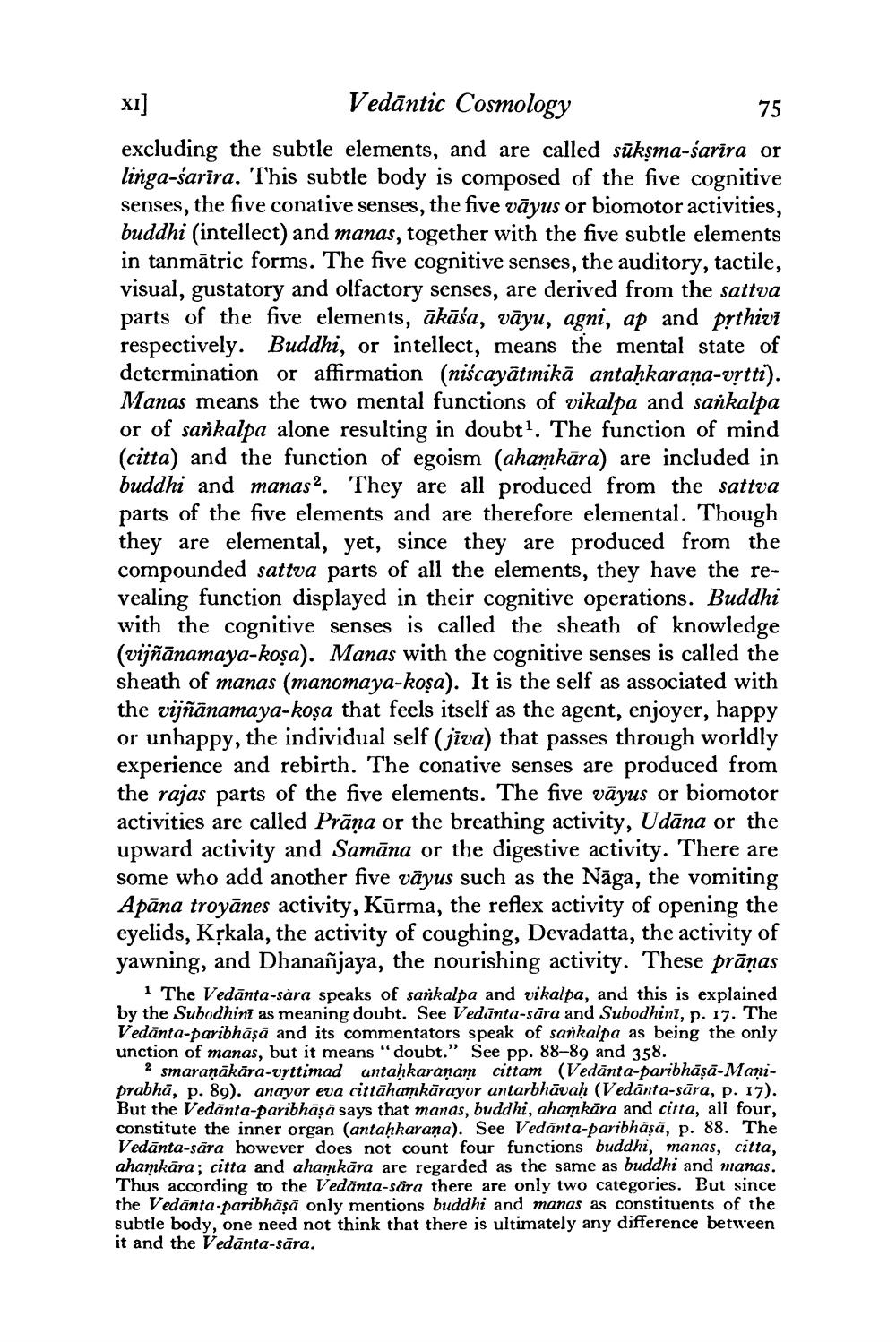________________
XI]
75
Vedāntic Cosmology excluding the subtle elements, and are called sūkşma-śarīra or linga-śarīra. This subtle body is composed of the five cognitive senses, the five conative senses, the five vāyus or biomotor activities, buddhi (intellect) and manas, together with the five subtle elements in tanmātric forms. The five cognitive senses, the auditory, tactile, visual, gustatory and olfactory senses, are derived from the sattva parts of the five elements, ākāśa, vāyu, agni, ap and prthivi respectively. Buddhi, or intellect, means the mental state of determination or affirmation (niscayātmikā antaḥkaraṇa-vrtti). Manas means the two mental functions of vikalpa and sankalpa or of sankalpa alone resulting in doubt?. The function of mind (citta) and the function of egoism (ahamkāra) are included in buddhi and manas. They are all produced from the sattva parts of the five elements and are therefore elemental. Though they are elemental, yet, since they are produced from the compounded sattva parts of all the elements, they have the revealing function displayed in their cognitive operations. Buddhi with the cognitive senses is called the sheath of knowledge (vijñānamaya-kosa). Manas with the cognitive senses is called the sheath of manas (manomaya-koşa). It is the self as associated with the vijñānamaya-koșa that feels itself as the agent, enjoyer, happy or unhappy, the individual self (jiva) that passes through worldly experience and rebirth. The conative senses are produced from the rajas parts of the five elements. The five vāyus or biomotor activities are called Prāņa or the breathing activity, Udāna or the upward activity and Samāna or the digestive activity. There are some who add another five vāyus such as the Nāga, the vomiting Apāna troyānes activity, Kūrma, the reflex activity of opening the eyelids, Kļkala, the activity of coughing, Devadatta, the activity of yawning, and Dhanañjaya, the nourishing activity. These prānas
1 The Vedānta-sára speaks of sankalpa and vikalpa, and this is explained by the Subodhini as meaning doubt. See Vedānta-sāra and Subodhini, p. 17. The Vedānta-paribhāşā and its commentators speak of sankalpa as being the only unction of manas, but it means "doubt." See pp. 88-89 and 358.
2 smaranākāra-urttimad untahkaranam cittam (Vedānta-paribhāṣā-Maniprabhā, p. 89). anayor eva cittāhamkārayor antarbhāvah (Vedānta-sūra, p. 17). But the Vedānta-paribhāṣā says that manas, buddhi, ahamkāra and citta, all four, constitute the inner organ (antahkarana). See Vedānta-paribhāṣā, p. 88. The Vedānta-sära however does not count four functions buddhi, manas, citta, ahamkāra; citta and ahamkāra are regarded as the same as buddhi and manas. Thus according to the Vedänta-sära there are only two categories. But since the Vedānta-paribhāṣā only mentions buddhi and manas as constituents of the subtle body, one need not think that there is ultimately any difference between it and the Vedānta-sāra.




